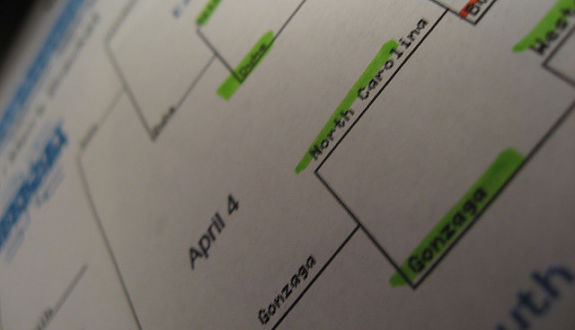March Law School Madness
- by
- Mar 23, 2016
- Admissions, Sports
- Reviewed by: Matt Riley


March Madness is upon us! I hope your NCAA tournament bracket is doing better than mine (c’mon Michigan State, really?). In keeping with the spirit of the season, this post is going to present a “mini-bracket” with different law schools facing off. To ratchet up the excitement, we’re going to start with a Final Four.
I’m going to talk a lot about the top-14 schools. The top-14 schools have been at the top of the rankings for a long time. They jockey for position between themselves, but they almost never shift outside the top-14 and they generally have the best employment statistics (by a wide margin).
Semi-Final 1: No. 1 Seed—Harvard, Yale, Stanford vs. No. 4 Seed—Strong Regional School with $$$
Harvard, Yale, and Stanford are the big three of the law school world. They reign supreme at the top of virtually every ranking list. Attending one of the three provides you with nearly unparalleled opportunities. Because it would be a slam dunk (get it, because March Madness) to receive an offer of admission and money from one of these schools, I’m going to assume there is no financial assistance on the table.
Squaring off against H/Y/S is a strong regional school, meaning a school outside of the top-14 that has strong employment opportunities and connections within a particular geographic region. Examples of such schools would include USC, Boston College, LSU, and William & Mary. To make things a little more competitive, I’m going to assume that either a full ride or a substantial scholarship is available to such a school.
And the winner is . . . Harvard, Yale, or Stanford!
There are obvious benefits to coming out of a school with no debt, especially if you’re interested in public interest work. Attending law school is an increasingly expensive and decreasingly secure option. Nevertheless, attending H/Y/S almost assuredly gives you the opportunity to work at a biglaw firm for a few years, thereby taking care of your debate, and opening the door to more prestigious and fulfilling employment opportunities thereafter.
Semi-Final 2: No. 2 Seed—Mid-Top 14 with $ vs. Lower Top 14 with $$
Here, the mid-top 14 (including Columbia, Chicago, NYU, Penn. and UVA) face off against the lower-top 14 (including Duke, Berkeley, Michigan, Northwestern, Cornell and Georgetown). To make things more competitive, I’m going to assume the offer to the mid-top 14 includes a 1/4 to 1/3 scholarship, and an offer to the lower-top 14 includes a 1/2 to 2/3 scholarship.
This one is a bit of a toss-up. Personal factors, including geographical preferences, debt aversion, and family connections, will probably play a decisive role in deciding between these two options. All else being equal, I would lean toward one of the mid-top 14 with $ over a lower-top 14 with $$. I think the extra employment security and increased geographical pull of a higher ranked school makes the extra cost worth it.
Final: H/Y/S vs. a Mid-Top 14 with $
I’ll try not to be a homer here (given that I attend a mid-top 14) and remain objective. The winner here is H/Y/S. As I noted above, the top 3 are the top 3 for a reason. They’re essentially in a league of their own. Again, numerous factors can come into play that might make it more personally worthwhile to attend another school, but the employment statistics and the doors that a JD from any of these schools will open make them worth the cost, even at “sticker.”
So I guess I lied about the intrigue and drama — the seeds played out as expected… which is surprising since I had absolutely no control over them. Anyway, H/Y/S comes out on top. If you manage to score an offer of admission from any of those three, I would probably take it and run.
Search the Blog

Free LSAT Practice Account
Sign up for a free Blueprint LSAT account and get access to a free trial of the Self-Paced Course and a free practice LSAT with a detailed score report, mind-blowing analytics, and explanatory videos.
Learn More
Popular Posts
-
logic games Game Over: LSAC Says Farewell to Logic Games
-
General LSAT Advice How to Get a 180 on the LSAT
-
Entertainment Revisiting Elle's LSAT Journey from Legally Blonde








